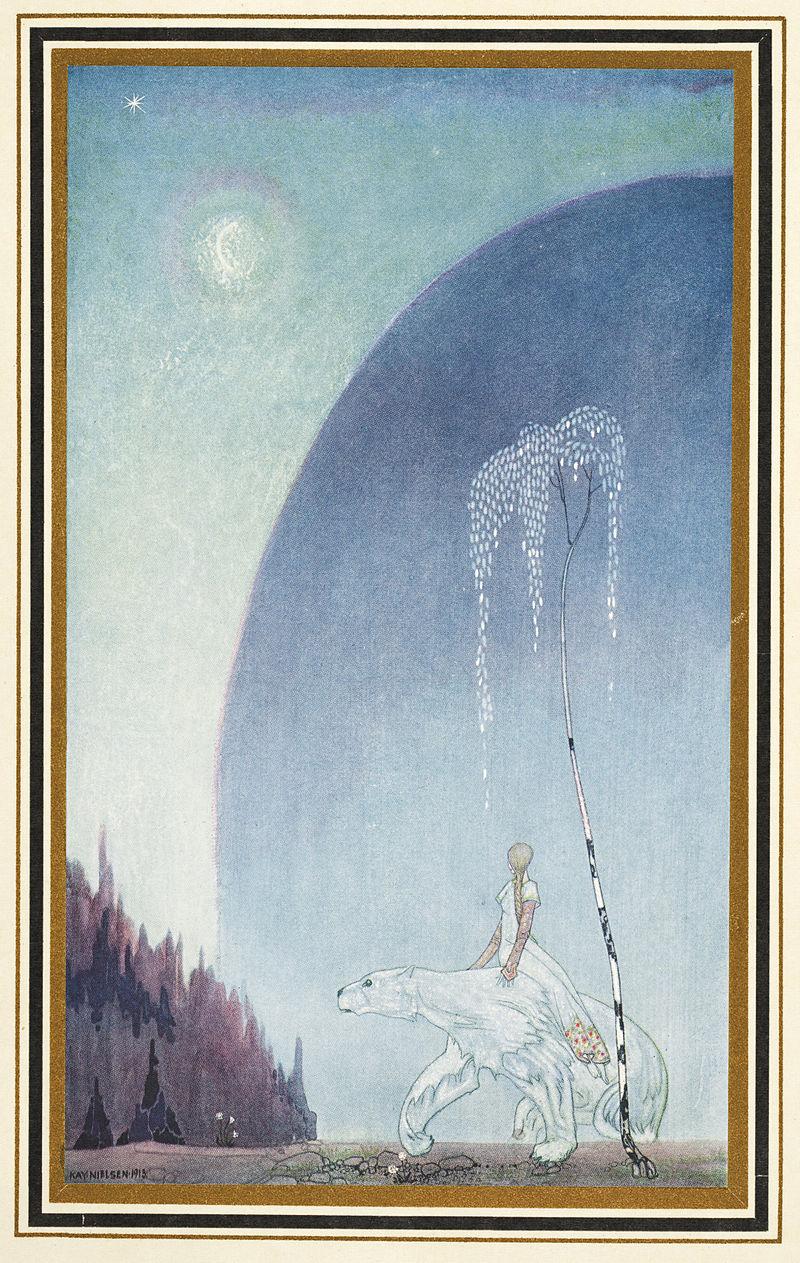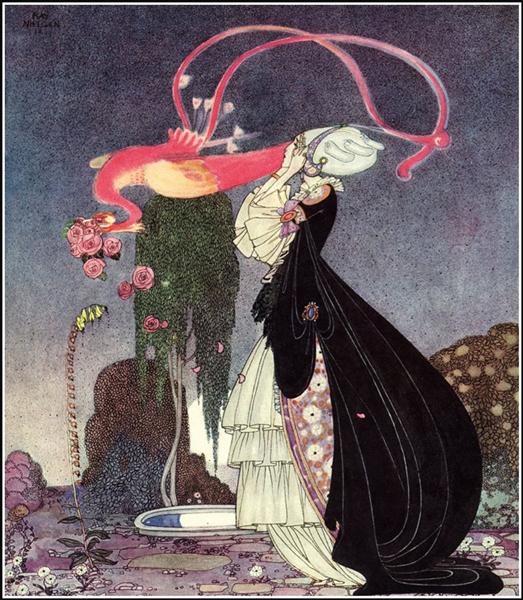42 Chapter 11 – Kay Nielsen
Art Nouveau
Audio recording of this chapter available here:

Kay Nielsen was born in Copenhagen into an artistic family; both of his parents were actors – Nielsen’s father, Martinus Nielsen, was the director of Dagmarteater and his mother, Oda Nielsen, was one of the most celebrated actresses of her time, both at the Royal Danish Theater and at the Dagmarteater.[1] Kay Nielsen studied art in Paris at Académie Julian and Académie Colarossi from 1904 to 1911.[2]

In 1914, Nielsen provided twenty-five colour plates and more than twenty-one monotone images for the children’s collection East of the Sun and West of the Moon. The colour images for both In Powder and Crinoline and East of the Sun and West of the Moon were reproduced by a four-colour process, in contrast to many of the illustrations prepared by his contemporaries that characteristically utilized a traditional three-colour process. Also in that year, Nielsen produced at least three illustrations depicting scenes from the life of Joan of Arc. When published later in the 1920s, these images were associated with relevant text from The Monk of Fife.

While painting landscapes in the Dover area, Nielsen came into contact with The Society of Tempera Painters where he learned new skills, and was able to reduce the time involved in the painting process. In 1917 Nielsen left for New York where an exhibition of his work was held and subsequently returned to Denmark. Together with a collaborator, Johannes Poulsen, he painted stage scenery for the Royal Danish Theatre in Copenhagen. During this time, Nielsen also worked on an extensive suite of illustrations intended to accompany a translation of The Arabian Nights that had been undertaken by the Arabic scholar, Professor Arthur Christensen. According to Nielsen’s own published comments, these illustrations were to be the basis of his return to book illustrations following a hiatus during World War I and the intention had been to publish the Danish version in parallel with versions for the English-speaking world and the French market. The project never came to fruition and Nielsen’s illustrations remained unknown until many years after his death.
During the 1920s, Nielsen returned to stagecraft in Copenhagen designing sets and costumes for professional theater. During that time, at age 40, he married the charismatic 22-year-old Ulla Pless-Schmidt and they became a devoted couple. At this point, he was Scandinavia’s most famous artist.[3]

Following his theatrical work in Copenhagen, Nielsen returned to contributing to illustrated books with the publication of Fairy Tales by Hans Andersen in 1924. That title included twelve colour plates and more than forty monotone illustrations. The colour images were prepared with integrated formal and informal borders; the informal borders were produced in a mille fleur style. A year later, Nielsen provided the artwork for Hansel and Gretel and Other Stories by the Brothers Grimm which was first published with twelve colour images and over twenty detailed monotone illustrations. A further five years passed before the publication of Red Magic, the final title to be illustrated comprehensively by Nielsen. The 1930 version of Red Magic included eight colours and more than fifty monotone contributions from the Danish artist.
In 1939 Nielsen left for California and worked for Hollywood companies. A personal recommendation from Joe Grant to Walt Disney secured Nielsen a job with The Walt Disney Company.[4] At Disney, his work was used in the Night on Bald Mountain and Ave Maria sequences of Fantasia.[5] Nielsen was renowned at the Disney studio for his concept art and he contributed artwork for many Disney films, including concept paintings for a proposed adaptation of Hans Christian Andersen’s The Little Mermaid. The adaptation was to be part of a package film containing various segments based on Andersen’s fairy tales. The film, however, was not made within Nielsen’s lifetime and his work went unused until production started on the 1989 film.[6] Nielsen worked for The Walt Disney Company for four years, from 1937 to 1941 before being let go due to budget constraints and Nielsen’s slow creation process.[7] Destitute, Nielsen died in illness and poverty, his work nearly forgotten until the 21st century.
Excerpted and adapted from: Wikipedia, (October 7 2020), s.v. “Kay Nielsen.” https://en.wikipedia.org/wiki/Kay_Nielsen
- Allan, Robin (1999). Walt Disney and Europe (1st ed.). John Libbey and Company, Ltd. p. 162 ↵
- Haase, Donald, ed. (2008). The Greenwood Encyclopedia of Fairy Tales & Folk Tales. 2 (1st ed.). Greenwood Press. p. 678 ↵
- "The brilliance of Kay Nielsen now on view". Greenfield Recorder. 2019-12-05. Retrieved 2020-08-28. ↵
- Allan, p. 30 ↵
- Johnston, Ollie; Thomas, Frank (1981). The Illusion of Life: Disney Animation (1st ed.). Walt Disney Productions. p. 139. ↵
- Allan, 163; (2006) Audio Commentary by John Musker, Ron Clements, and Alan Menken Bonus material from The Little Mermaid: Platinum Edition [DVD]. Walt Disney Home Entertainment. ↵
- Haase, Donald, ed. (2008). The Greenwood Encyclopedia of Fairy Tales & Folk Tales. 2 (1st ed.). Greenwood Press. p. 678. ↵

